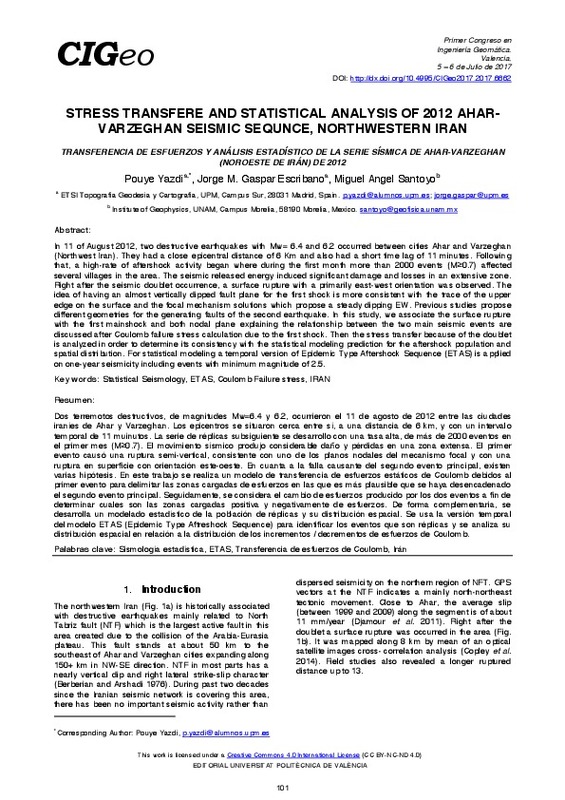JavaScript is disabled for your browser. Some features of this site may not work without it.
Buscar en RiuNet
Listar
Mi cuenta
Estadísticas
Ayuda RiuNet
Admin. UPV
Stress transfere and statistical analysis of 2012 Ahar-Varzeghan siesmic sequence, Northwestern Iran
Mostrar el registro sencillo del ítem
Ficheros en el ítem
| dc.contributor.author | Yazdi, Pouye
|
es_ES |
| dc.contributor.author | Gaspar Escribano, Jorge
|
es_ES |
| dc.contributor.author | Santoyo, Miguel Angel
|
es_ES |
| dc.coverage.spatial | east=53.688045999999986; north=32.427908; name= Iran | es_ES |
| dc.date.accessioned | 2018-04-19T10:29:38Z | |
| dc.date.available | 2018-04-19T10:29:38Z | |
| dc.date.issued | 2017-10-23 | |
| dc.identifier.isbn | 9788490486696 | |
| dc.identifier.uri | http://hdl.handle.net/10251/100651 | |
| dc.description.abstract | [EN] In 11 of August 2012, two destructive earthquakes with Mw= 6.4 and 6.2 occurred between cities Ahar and Varzeghan (Northwest Iran). They had a close epicentral distance of 6 Km and also had a short time lag of 11 minutes. Following that, a high-rate of aftershock activity began where during the first month more than 2000 events (M≥0.7) affected several villages in the area. The seismic released energy induced significant damage and losses in an extensive zone. Right after the seismic doublet occurrence, a surface rupture with a primarily east-west orientation was observed. The idea of having an almost vertically dipped fault plane for the first shock is more consistent with the trace of the upper edge on the surface and the focal mechanism solutions which propose a steady dipping EW. Previous studies propose different geometries for the generating faults of the second earthquake. In this study, we associate the surface rupture with the first mainshock and both nodal plane explaining the relationship between the two main seismic events are discussed after Coulomb failure stress calculation due to the first shock. Then the stress transfer because of the doublet is analyzed in order to determine its consistency with the statistical modeling prediction for the aftershock population and spatial distribution. For statistical modeling a temporal version of Epidemic Type Aftershock Sequence (ETAS) is applied on one-year seismicity including events with minimum magnitude of 2.5. | es_ES |
| dc.description.abstract | [ES] Dos terremotos destructivos, de magnitudes Mw=6.4 y 6.2, ocurrieron el 11 de agosto de 2012 entre las ciudades iraníes de Ahar y Varzeghan. Los epicentros se situaron cerca entre sí, a una distancia de 6 km, y con un intervalo temporal de 11 muinutos. La serie de réplicas subsiguiente se desarrollo con una tasa alta, de más de 2000 eventos en el primer mes (M≥0.7). El movimiento sísmico produjo considerable daño y pérdidas en una zona extensa. El primer evento causó una ruptura semi-vertical, consistente con uno de los planos nodales del mecanismo focal y con una ruptura en superficie con orientación este-oeste. En cuanta a la falla causante del segundo evento principal, existen varias hipótesis. En este trabajo se realiza un modelo de transferencia de esfuerzos estáticos de Coulomb debidos al primer evento para delimitar las zonas cargadas de esfuerzos en las que es más plausible que se haya desencadenado el segundo evento principal. Seguidamente, se considera el cambio de esfuerzos producido por los dos eventos a fin de determinar cuales son las zonas cargadas positiva y negativamente de esfuerzos. De forma complementaria, se desarrolla un modelado estadístico de la población de réplicas y su distribución espacial. Se usa la versión temporal del modelo ETAS (Epidemic Type Aftreshock Sequence) para identificar los eventos que son réplicas y se analiza su distribución espacial en relación a la distribución de los incrementos / decrementos de esfuerzos de Coulomb. | es_ES |
| dc.format.extent | 7 | es_ES |
| dc.language | Inglés | es_ES |
| dc.publisher | Editorial Universitat Politècnica de València | es_ES |
| dc.relation.ispartof | Primer Congreso en Ingeniería Geomática. Libro de actas | es_ES |
| dc.rights | Reconocimiento - No comercial - Sin obra derivada (by-nc-nd) | es_ES |
| dc.subject | Statistical Seismology | es_ES |
| dc.subject | ETAS | es_ES |
| dc.subject | Coulomb Failure stress | es_ES |
| dc.subject | Irán | es_ES |
| dc.subject | Sismología estadística | es_ES |
| dc.subject | Transferencia de esfuerzos de Coulomb | es_ES |
| dc.title | Stress transfere and statistical analysis of 2012 Ahar-Varzeghan siesmic sequence, Northwestern Iran | es_ES |
| dc.title.alternative | Transferencia de esfuerzos y análisis estadístico de la serie sísmica de Ahar-Varzehan (Noroeste de Irán) de 2012 | es_ES |
| dc.type | Capítulo de libro | es_ES |
| dc.type | Comunicación en congreso | es_ES |
| dc.identifier.doi | 10.4995/CIGeo2017.2017.6662 | |
| dc.rights.accessRights | Abierto | es_ES |
| dc.description.bibliographicCitation | Yazdi, P.; Gaspar Escribano, J.; Santoyo, MA. (2017). Stress transfere and statistical analysis of 2012 Ahar-Varzeghan siesmic sequence, Northwestern Iran. En Primer Congreso en Ingeniería Geomática. Libro de actas. Editorial Universitat Politècnica de València. 101-106. https://doi.org/10.4995/CIGeo2017.2017.6662 | es_ES |
| dc.description.accrualMethod | OCS | es_ES |
| dc.relation.conferencename | 1st Congress in Geomatics Engineering | es_ES |
| dc.relation.conferencedate | July 05-06,2017 | es_ES |
| dc.relation.conferenceplace | Valencia, Spain | es_ES |
| dc.relation.publisherversion | http://ocs.editorial.upv.es/index.php/CIGeo/CIGeo2017/paper/view/6662 | es_ES |
| dc.description.upvformatpinicio | 101 | es_ES |
| dc.description.upvformatpfin | 106 | es_ES |
| dc.type.version | info:eu-repo/semantics/publishedVersion | es_ES |
| dc.relation.pasarela | OCS\6662 | es_ES |








